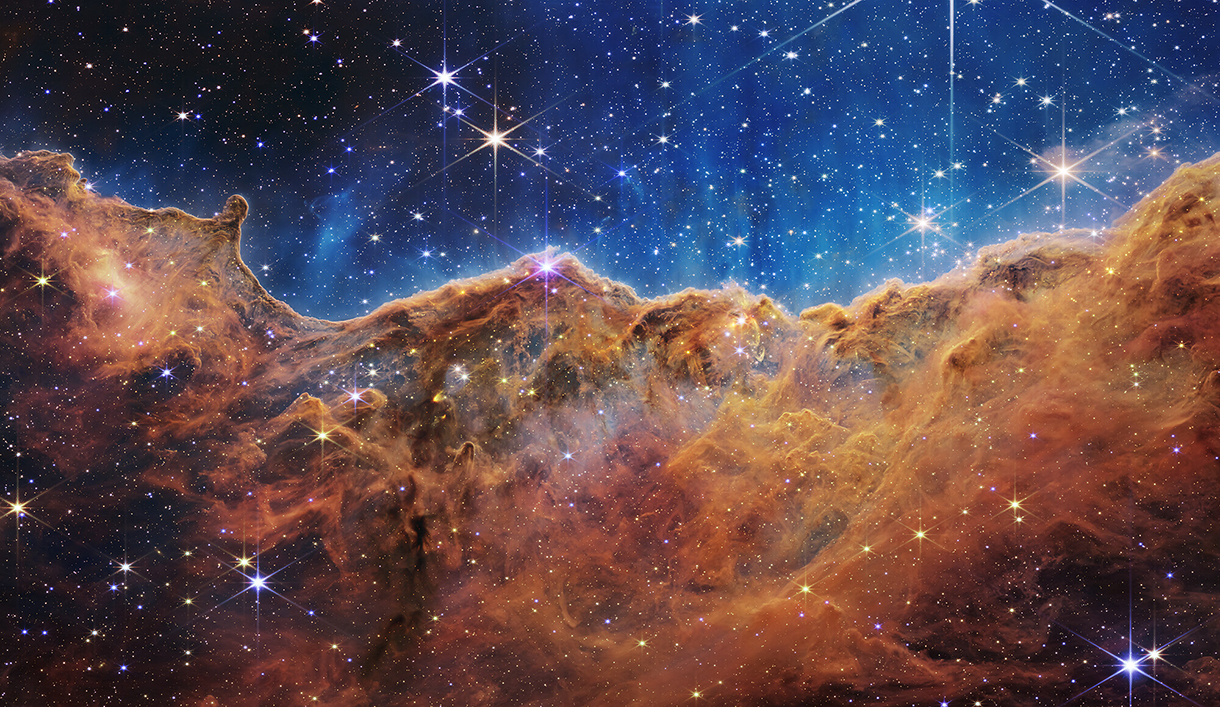First Webb Space Telescope images are here
The first images from the James Webb Space Telescope (Webb)—the largest space observatory ever built—were livestreamed Tuesday, July 12 on NASA Live. The product of decades of development and testing, Webb carries contributions from a generation of University of Maryland engineering alumni. Webb’s Near Infrared Spectrograph (NIRSpec), a breakthrough instrument developed at the NASA Goddard Space Flight Center, is designed to observe up to 100 space objects simultaneously. Two UMD alumni—Wen-Hsien Chuang (ECE PhD 2005) and Dan Kelly (ECE MS 2005; ECE BS 2002)—played important roles in inventing and building the micro-electromechanical systems (MEMS) microshutter array that controls how light enters NIRSpec. Kelly, one of Professor Reza Ghodssi’s (ECE/ISR) early students, has spent his career at NASA Goddard Space Flight Center, where he is an electronics systems engineer in the Detector Systems Branch. Kelly’s education in MEMS microelectronics and fabrication at Maryland led to him working on the NIRSpec microshutter array for 10 years. Chuang helped pave the way for the microshutters by performing the first electromechanical characterization of MEMS actuators at cryogenic temperatures in his Ph.D. thesis work on MEMS-based silicon nitride thin film materials and devices. Chuang was Ghodssi’s first Ph.D. student and joined Intel shortly after earning his doctorate. He has been with the company for more than 16 years. Chuang is looking forward to Webb providing key information “to help us unfold the universe.” We asked him for his thoughts a few days before the first pictures were released. “I am so excited to see that Webb, which I made contributions to, will transmit its first official photos on Tuesday,” Chuang said. “As an engineer and technologist, there is nothing more you can ask than to have a chance to work on a project that helps human beings understand the origin of the universe and write a new page in our history. I am ready to join the heated discussions around the world on the origin of the universe once we see these amazing pictures!” Alum Kan Yang (AE MS 2010) also played a key role in determining whether Webb’s instruments would work in the extreme cold of space. As the Lead Thermal Analyst for the OTIS Cryo-Vacuum Test, Yang was responsible for developing a way to cool the telescope to the temperatures that it would be exposed to in space; to establish the thermal conditions to perform the optical, thermal, and thermal distortion tests; and then to warm everything back up to room temperature. Here's what Yang had to say shortly before the photos were released. “I’m absolutely thrilled about the successes of Webb so far and I feel incredibly fortunate that I had the opportunity to make a small contribution to such a revolutionary and groundbreaking observatory,” Yang says. “I keep thinking back to a passage I read from Carl Sagan while I was in college: ‘We are a way for the universe to know itself.’ I find it somewhat poetic that we are the result of billions of years of cosmic evolution and finally, through our intellect and all the hurdles we’ve overcome in technology, we are able to peer back to the beginning and truly understand and observe the events that created us. In a way, we’ve come full circle, and It’s a really humbling thought. “I’ve been following all of the interest and excitement from the general public with each new phase of commissioning and each new test picture released by the team. I’m elated that there’s so much interest in the telescope, and now on the eve of the first science photos being released, I hope that what we see will give folks a profound sense of wonder at the beauty of the universe and their place in it, as well as unite us in marveling at what we can achieve as a species when we work together. “ About the first images The cosmic objects Webb has targeted for these first observations represent the first wave of full-color scientific images and spectra the observatory has gathered, and the official beginning of Webb’s general science operations. They were selected by an international committee of representatives from NASA, ESA, CSA, and the Space Telescope Science Institute. Carina Nebula: The Carina Nebula is one of the largest and brightest nebulae in the sky, located approximately 7,600 light-years away in the southern constellation Carina. Nebulae are stellar nurseries where stars form. The Carina Nebula is home to many massive stars, several times larger than the Sun. WASP-96 b (spectrum): WASP-96 b is a giant planet outside our solar system, composed mainly of gas. The planet, located nearly 1,150 light-years from Earth, orbits its star every 3.4 days. It has about half the mass of Jupiter, and its discovery was announced in 2014. Southern Ring Nebula: The Southern Ring, or “Eight-Burst” nebula, is a planetary nebula – an expanding cloud of gas, surrounding a dying star. It is nearly half a light-year in diameter and is located approximately 2,000 light years away from Earth. Stephan’s Quintet: About 290 million light-years away, Stephan’s Quintet is located in the constellation Pegasus. It is notable for being the first compact galaxy group ever discovered in 1877. Four of the five galaxies within the quintet are locked in a cosmic dance of repeated close encounters. SMACS 0723: Massive foreground galaxy clusters magnify and distort the light of objects behind them, permitting a deep field view into both the extremely distant and intrinsically faint galaxy populations.
Related Articles: July 11, 2022 Prev Next |
|


